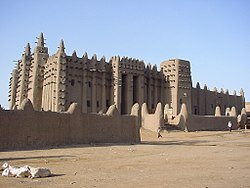| WARNING: Most of the Sahel remains unsafe for travel because of civil wars, insurgencies, and terrorism; especially in Sudan, Chad, Niger, and Mali. See the respective warnings in each of these countries' articles. | |
| (Information last updated 29 Aug 2025) |
The Sahel is a region of Africa at the southern edge of the Sahara Desert.
Countries
[edit]
| Chad Well off-the-beaten-path for all but the hardiest of travellers; very unstable in the north. |
| Mali A country with a remarkable history and heritage; home to the ancient trade capitals and seats of learning of Djenné and Timbuktu. |
| Mauritania Quite possibly the safest and most modern country in the region; visitor interest here is primarily centred on the Saharan dune regions. |
| Niger Similar to neighbouring Mali and perhaps the most popular Sahelian country with travellers. |
| Sudan One of the largest countries in Africa and home to the world's oldest continuous major civilisations; it has been highly prone to conflict. |

Cities
[edit]There is a very small population in this region of Africa. Cities are rare and far between but here are the main ones.
- 1 Agadez — historically a very important stage on the trans-Saharan caravan routes in northern Niger
- 2 Bamako — capital of Mali
- 3 Khartoum — capital of Sudan and by far the largest city in the region
- 4 Mopti — one of the main ports in Mali and a good gateway for many impressive attractions such as Djenné, Timbuktu, and Dogon Country.
- 5 N'Djamena — capital of Chad
- 6 Niamey — capital of Niger and perhaps the most accessible Sahelian city for the traveler
- 7 Nouakchott — capital of Mauritania
- 8 Port Sudan — large Red Sea port city
- 9 Timbuktu — a city of great historical importance particularly for education and the spread of Islam.
Other destinations
[edit]
- 1 Balleyara Market — two hours from Niamey in Niger, one of West Africa's largest animal markets, plus a colorful array of other traditional market and artisanal goods (Sundays)
- 2 Dogon Country — a trek through this landscape of scattered cliff-side villages in is not to be missed by any Mali visitor
- 3 Djenne — once a religious and commercial center to rival Timbuktu, this small town of multi-storey mud buildings in Mali is quite a sight
- 4 W National Park — a large trans-border national park, most accessible from Niamey in Niger
- 5 Lake Chad
Understand
[edit]|
Ramadan
Ramadan is the 9th and holiest month in the Islamic calendar and lasts 29–30 days. Muslims fast every day for its duration and most restaurants will be closed until the fast breaks at dusk. Nothing (including water and cigarettes) is supposed to pass through the lips from dawn to sunset. Non-Muslims are exempt from this, but should still refrain from eating or drinking in public as this is considered very impolite. Working hours are decreased as well in the corporate world. Exact dates of Ramadan depend on local astronomical observations and may vary somewhat from country to country. Ramadan concludes with the festival of Eid al-Fitr, which may last several days, usually three in most countries.
If you're planning to travel to Sahel during Ramadan, consider reading Travelling during Ramadan. |
The Sahel runs 3,862 km from the Atlantic Ocean coast of Mauritania in the west to the Red Sea coast of Sudan in the east. The ecoregion definition takes in part of other countries but for the purposes of this travel guide, it includes all of Chad, Mali, Mauritania, Niger and Sudan. The region consists of semi-arid grasslands, savannas, steppes, and thorn shrublands lying between the Central African wooded savanna to the south, and the Sahara to the north.
The topography of the Sahel is mainly flat, and the region mostly lies between 200 and 400 m elevation.
History
[edit]Over the history of Africa the region has been home to some of the most advanced kingdoms benefiting from trade across the desert. Collectively these states are known as the Sahelian kingdoms which were a series of empires, based in the Sahel, which had many similarities. The wealth of the states came from controlling the Trans-Saharan trade routes across the desert. Their power came from having large pack animals like camels and horses that were fast enough to keep a large empire under central control and were also useful in battle. The first large Sahelian kingdoms emerged after 750, and supported several large trading cities in the Niger Bend region, including Timbuktu, Gao, and Djenné.
During the 19th century, the French colonized the Western and Central Sahel while the Muhammed Ali of Egypt invaded the Eastern Sahel (Sudan) in 1820. Eventually the British became the de facto occupiers of Sudan. Every Sahelian country achieved independence from their respective European colonial power over the 1950s and 1960s.
Unfortunately, due to the region's constant instability and coups in the 21st-century, the region has colloquially earned the nickname of "coup belt". Travel to this region is one of the most off-the-beaten-path destinations in the world, as more extremist groups centre themselves in the Sahel.
Climate
[edit]Annual rainfall varies from around 100-200 mm in the north of the Sahel to around 700-900 mm in the south.
Read
[edit]Overland travel in the region is covered extensively in the book Sahara (ISBN 0297843036) by Michael Palin, detailing a journey they did for a BBC programme back in 2001.
Get in
[edit]Get around
[edit]See
[edit]
